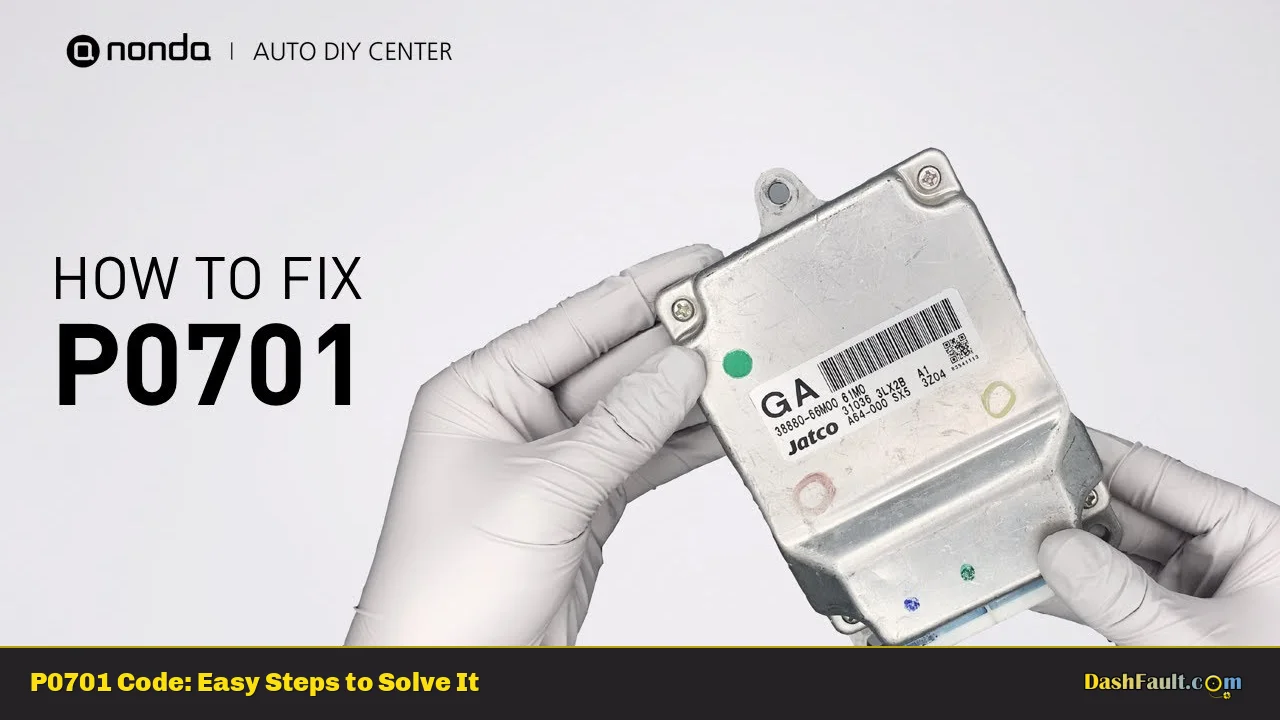The P0701 diagnostic trouble code (DTC) indicates a malfunction in the transmission control system’s range or performance. This code is specific to vehicles equipped with automatic transmissions and is triggered when the powertrain control module (PCM) detects that the transmission control system is not operating within its expected parameters. The P0701 code is often accompanied by other transmission-related codes, making it crucial for vehicle owners and DIY mechanics to understand its implications, symptoms, and resolution steps.
| P0701 Code Meaning | P0701 Code Common Causes |
|---|---|
| Transmission Control System Range/Performance Issue | Low transmission fluid level or poor-quality fluid |
| Indicates a malfunction in the automatic transmission control system | Faulty transmission sensors or solenoids |
| May enter limp-in mode to protect the transmission | Wiring or connector issues within the transmission control circuit |
| Can lead to erratic shifting or failure to shift | Mechanical failures within the transmission assembly |
| Torque converter problems |
Symptoms of P0701 Code
When the P0701 code is triggered, several symptoms may manifest, indicating issues with the vehicle’s transmission:
- Erratic Shifting Patterns: Drivers may notice that the vehicle shifts gears unpredictably or harshly.
- Failure to Shift: The transmission may become stuck in one gear or fail to shift at all, leading to a lack of acceleration.
- Decreased Fuel Efficiency: Poor transmission performance can result in increased fuel consumption.
- Transmission Slippage: The vehicle may experience slipping, where it unexpectedly loses power during acceleration.
- Delayed Engagement: There may be a noticeable delay when shifting from park to drive or reverse.
Technical Explanation of P0701 Code
The P0701 code specifically relates to the electronic control of the automatic transmission. The PCM uses input from various sensors, including the throttle position sensor and vehicle speed sensor, to determine the optimal shift points and hydraulic pressure needed for smooth operation. If any of these components fail or if there are issues within the transmission itself, the PCM will register a P0701 code.
Step-by-Step Diagnosis
Diagnosing a P0701 code requires a systematic approach:
- Initial Scan: Use an OBD-II scanner to confirm that the P0701 code is present and check for any additional codes that may provide context.
- Visual Inspection: Inspect wiring and connectors related to the transmission control system for signs of damage, corrosion, or loose connections.
- Check Fluid Levels: Verify that the transmission fluid is at the correct level and in good condition (not burnt or contaminated).
- Sensor Testing: Test the operation of key sensors (e.g., throttle position sensor, vehicle speed sensor) using a digital volt/ohmmeter.
- Solenoid Functionality: Check if the transmission solenoids are functioning correctly by testing their resistance and operation.
- Road Test: Conduct a road test to observe how the vehicle behaves under various driving conditions.
Solution Methods for P0701 Code
Resolving the P0701 code can involve several methods depending on the underlying cause:
- Fluid Change: If low or contaminated fluid is detected, perform a complete fluid change and replace any filters as necessary. Ensure that you use manufacturer-recommended fluid types.
- Sensor Replacement: If tests indicate that any sensors are malfunctioning, replace them with OEM parts for optimal compatibility.
- Wiring Repairs: Repair any damaged wiring or connectors found during inspection. Ensure all connections are secure and free from corrosion.
- Solenoid Replacement: If solenoids are found to be faulty, they should be replaced. This may require dropping the transmission pan for access.
- Professional Diagnosis: If initial diagnostics do not reveal clear issues, consider consulting with a professional mechanic who can perform advanced diagnostics.
Cost Estimates
The cost of resolving a P0701 code can vary widely based on several factors:
- Fluid Change: $100 – $200 depending on labor and fluid costs.
- Sensor Replacement: $50 – $300 per sensor based on part prices and labor rates.
- Wiring Repairs: $100 – $500 depending on severity and accessibility of wiring issues.
- Solenoid Replacement: $150 – $600 depending on number of solenoids and labor involved.
- Professional Diagnosis: $75 – $150 for diagnostic services if needed.
Warnings and Recommendations
- Always ensure that you have proper tools and knowledge before attempting repairs on your vehicle’s transmission system.
- If you are unsure about any step in diagnosing or repairing your vehicle, it’s best to seek professional assistance to avoid further damage.
- Be cautious of driving your vehicle if you suspect a serious issue with your transmission; operating in limp mode can lead to additional problems over time.
Frequently Asked Questions About P0701
- What does the P0701 code mean?
The P0701 code indicates a problem with the Transmission Control System Range/Performance detected by the PCM. - Can I drive my vehicle with a P0701 code?
It is not advisable as it may lead to further damage; limp mode restricts performance. - What are common causes of P0701?
Common causes include low fluid levels, faulty sensors, electrical issues, and mechanical failures. - How do I reset a P0701 code?
You can reset it using an OBD-II scanner after addressing the underlying issue. - Is it safe to repair P0701 myself?
If you have experience with automotive repairs, you can attempt it; otherwise, consult a professional. - What tools do I need to diagnose a P0701 code?
An OBD-II scanner, digital volt/ohmmeter, basic hand tools for inspections are essential. - How long does it take to fix a P0701 code?
The time varies based on diagnosis complexity; simple fixes might take 2-4 hours. - Will clearing the code fix my problem?
No, clearing the code without addressing its cause will result in it reappearing.
In conclusion, understanding and addressing the P0701 trouble code is critical for maintaining your vehicle’s performance and reliability. By following systematic diagnostic steps and employing appropriate repair methods, both vehicle owners and DIY mechanics can effectively resolve this issue. Always prioritize safety and seek professional help when necessary to ensure your vehicle operates smoothly and efficiently.
